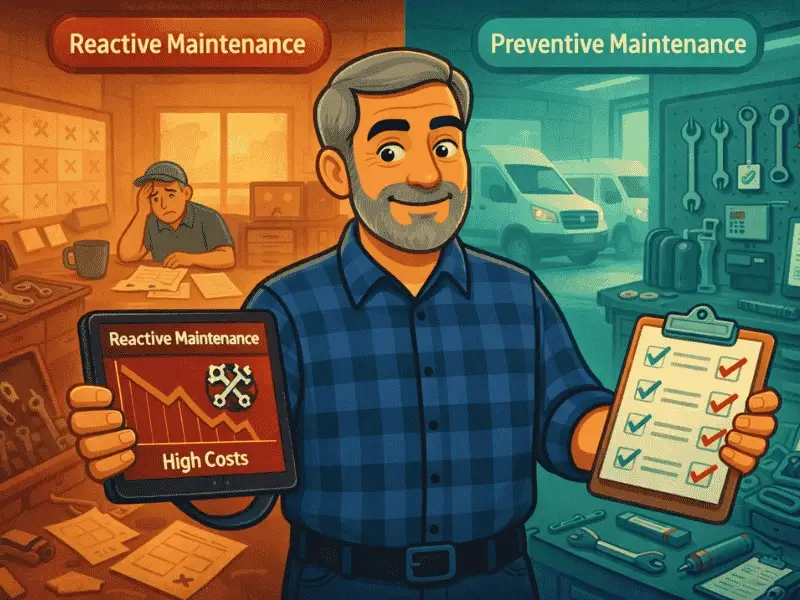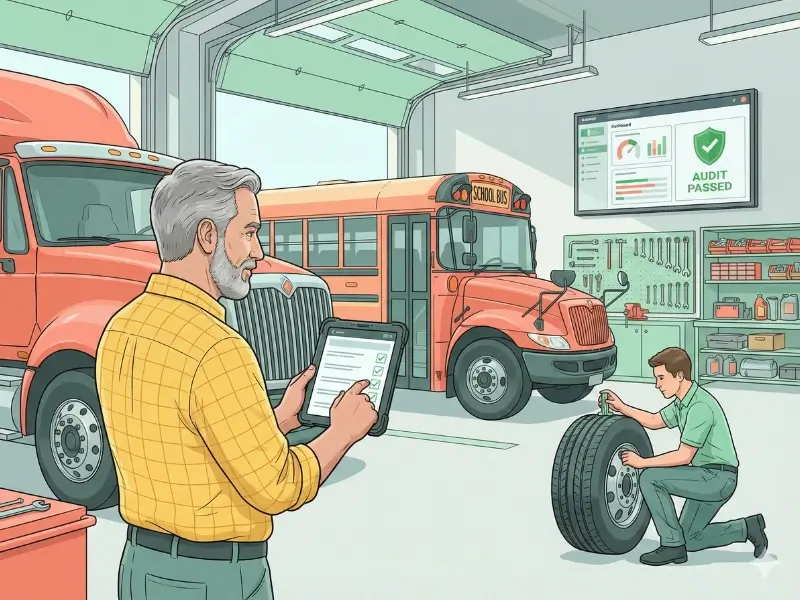Key Takeaways
- ELD compliance is mandatory for most fleets and ensures accurate tracking of Hours of Service (HOS).
- ELDs improve safety, reduce paperwork, and streamline inspections through automated, tamper-proof logs.
- The right ELD must be FMCSA-registered and support data transfer, engine sync, and driver protections.
- Successful ELD adoption involves training, phased rollouts, and software integration.
- ELD compliance boosts efficiency, lowers costs, and helps fleets avoid violations.
Electronic Logging Device (ELD) compliance is an essential part of running a safe, efficient, and successful fleet in today’s transportation industry. If you manage a fleet, understanding the Federal Motor Carrier Safety Administration’s (FMCSA) ELD mandate and how to stay compliant can save you time, money, and stress. This article breaks down the key information you need to navigate ELD compliance confidently and effectively.
What Is an ELD and Why Is It Important?
An Electronic Logging Device (ELD) is a technology installed in commercial vehicles that automatically records driving time and Hours of Service (HOS). The primary goal is to help drivers and fleet managers track working hours accurately, preventing driver fatigue and improving road safety.
Before the ELD mandate, many drivers relied on paper logbooks or earlier electronic on-board recorders (AOBRDs). These methods were prone to errors, tampering, and inconsistencies, which could lead to unsafe practices and regulatory penalties. The ELD mandate was introduced to standardize HOS recording and make compliance easier and more reliable.
ELDs connect directly to the vehicle’s engine and capture data such as engine hours, miles driven, ignition status, and GPS location. This data syncs with a mobile app that drivers use to view and manage their logs. Fleet managers can monitor the same data through fleet management software, allowing for better oversight and planning.
Who Must Comply with the ELD Mandate?
The FMCSA requires most commercial motor vehicle (CMV) drivers who are required to maintain Records of Duty Status (RODS) to use compliant ELDs. Here’s a quick rundown:
- Who Must Comply: Drivers operating interstate and required to maintain RODS for 8 or more days within a 30-day rolling period.
- Who Is Exempt: Drivers of vehicles manufactured before model year 2000
- Driveaway-towaway drivers (where the vehicle driven is the shipment)
- Drivers who keep RODS for fewer than 8 days in any 30-day period
- Certain short-haul local drivers meeting specific mileage and time limits
- Insect and livestock haulers
Even if your fleet falls under some exemptions, installing ELDs can offer operational benefits worth considering.
Core ELD Compliance Requirements
To meet FMCSA regulations, an ELD must meet several strict requirements:
- Automatic Engine Connection: The device must be wired into the engine control module to capture driving time automatically.
- Duty Status Options: Drivers must be able to easily select duty statuses like Driving, On-Duty (not driving), Off-Duty, and Sleeper Berth.
- Data Transfer: ELDs must support transferring data to enforcement officials via wireless methods, USB, or Bluetooth.
- Tamper Resistance: The system must protect logs from unauthorized edits or deletions while preserving original data.
- Certification and Registration: ELDs must be self-certified by manufacturers and registered with FMCSA.
- Driver Protections: Rules prevent harassment or coercion of drivers to falsify logs or violate HOS limits.
Benefits of ELD Compliance Beyond Regulation
While compliance is mandatory, the benefits of using ELDs extend far beyond simply avoiding fines:
- Improved Driver Safety: Accurate HOS tracking helps prevent fatigue-related accidents, keeping your drivers and others safer on the road.
- Simplified Record Keeping: ELDs eliminate paper logs and reduce errors, making audits and inspections quicker and less stressful.
- Faster Roadside Inspections: Data can be quickly shared with enforcement officials, reducing downtime.
- Enhanced Fleet Efficiency: GPS tracking and telematics help optimize routes, reduce idle times, and lower fuel costs.
- Automated Reporting: Many systems automate IFTA fuel tax reporting and maintenance alerts, saving administrative time.
- Better Data for Decision Making: Real-time visibility into driver and vehicle status supports smarter operational decisions.
Common Challenges and How to Overcome Them
Adopting ELDs isn’t without hurdles. Here are some typical challenges and tips to address them:
Driver Resistance
Some drivers may resist new technology due to unfamiliarity or fear of being monitored.
Solution: Provide thorough training and emphasize how ELDs protect drivers by preventing unsafe driving hours.
Installation Issues
Incorrect installation can cause device malfunctions or inaccurate data capture.
Solution: Use certified installers and perform post-installation testing to ensure everything works properly.
Data Management
Managing large amounts of data can overwhelm your back-office teams.
Solution: Choose fleet management software that integrates ELD data seamlessly and offers clear dashboards and alerts.
Regulatory Confusion
Differing state and federal rules, especially for intrastate operations, can complicate compliance.
Solution: Stay updated on both FMCSA and state-specific requirements to ensure full compliance.
Best Practices for ELD Implementation
Successful ELD adoption involves more than just plugging in a device. Consider these steps:
- Plan Ahead: Start early and map out a clear implementation timeline to avoid last-minute issues.
- Pilot Program: Roll out ELDs with a small group of drivers first to identify and fix potential problems.
- Train Drivers Thoroughly: Make sure drivers understand how to use the devices, how to handle log edits, and their rights under the mandate.
- Communicate Openly: Keep lines of communication open for driver feedback and support requests.
- Assign Compliance Responsibility: Designate a compliance manager or team to monitor ELD data regularly and address issues promptly.
- Integrate Systems: Connect ELD data to your existing fleet management, payroll, and maintenance systems for maximum efficiency.
Choosing the Right ELD Solution
Not all ELD solutions are created equal. When selecting a system, look for:
- FMCSA Registration: Confirm the device is on the official FMCSA registered list.
- Multiple Data Transfer Options: Bluetooth, USB, and wireless capabilities ensure data can always be shared with enforcement officials.
- Ease of Use: Intuitive driver interfaces and mobile apps reduce training time and user errors.
- Additional Features: Look for GPS tracking, driver vehicle inspection reporting (DVIR), engine fault notifications, and automated reporting capabilities.
- Reliable Customer Support: 24/7 expert support can minimize downtime and frustration, especially for drivers on the road.
- Cost-Effectiveness: Consider both upfront costs and ongoing subscription fees, balancing them with potential savings in fines, fuel, and administrative time.
Final Thoughts
ELD compliance is an essential piece of modern fleet management that protects your business, drivers, and customers. It may seem complex at first, but with the right knowledge, technology, and support, it becomes a powerful tool to enhance safety, efficiency, and profitability.
If you haven’t yet adopted ELDs or are considering switching providers, now is the time to act. Start planning your implementation, educate your team, and choose a solution that fits your fleet’s unique needs.
Ready to simplify your ELD compliance? Contact us today to learn how our integrated fleet management solutions can keep your trucks moving safely and efficiently, while keeping you fully compliant with FMCSA regulations.



.png)








.png)


.png)









